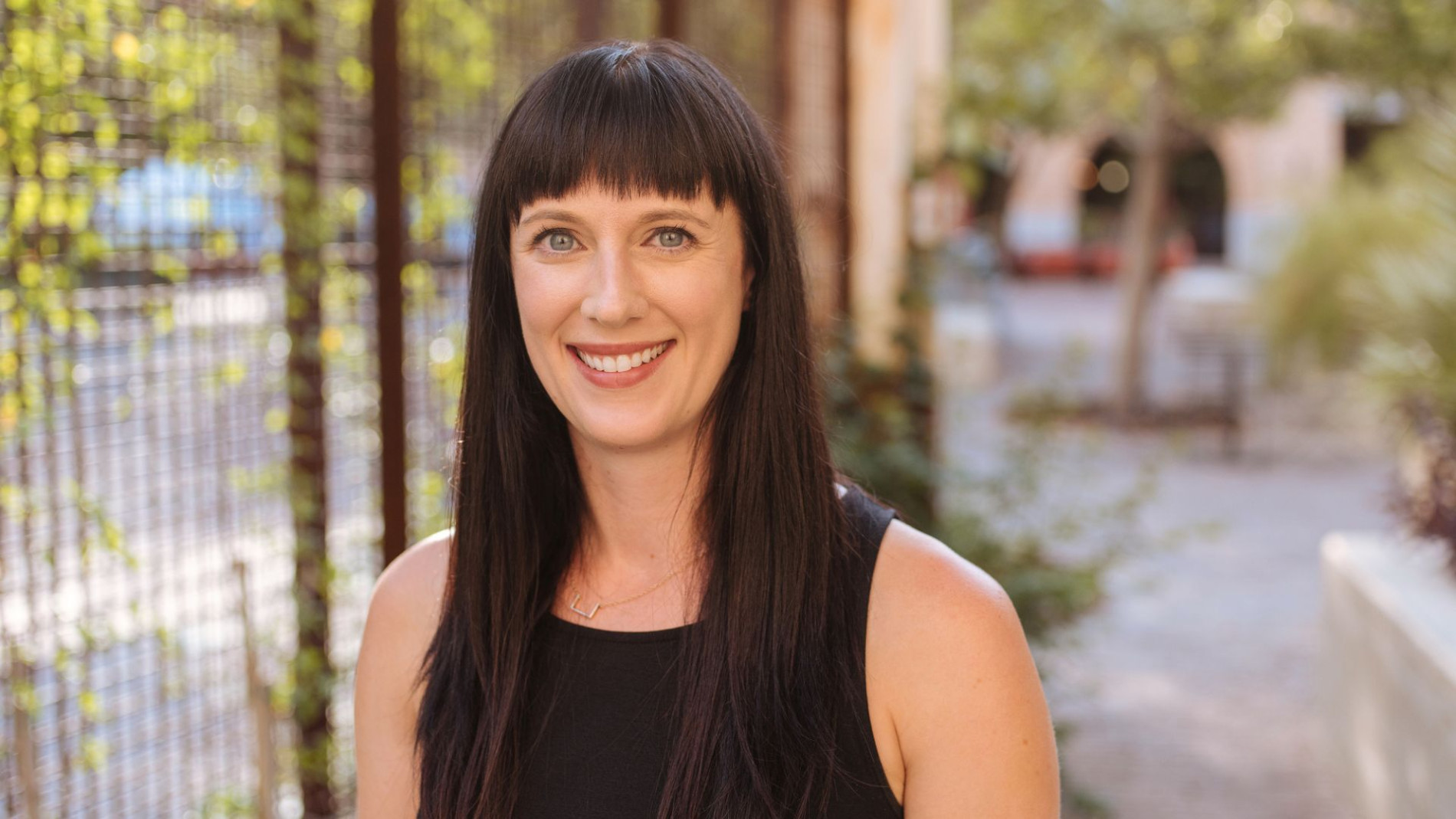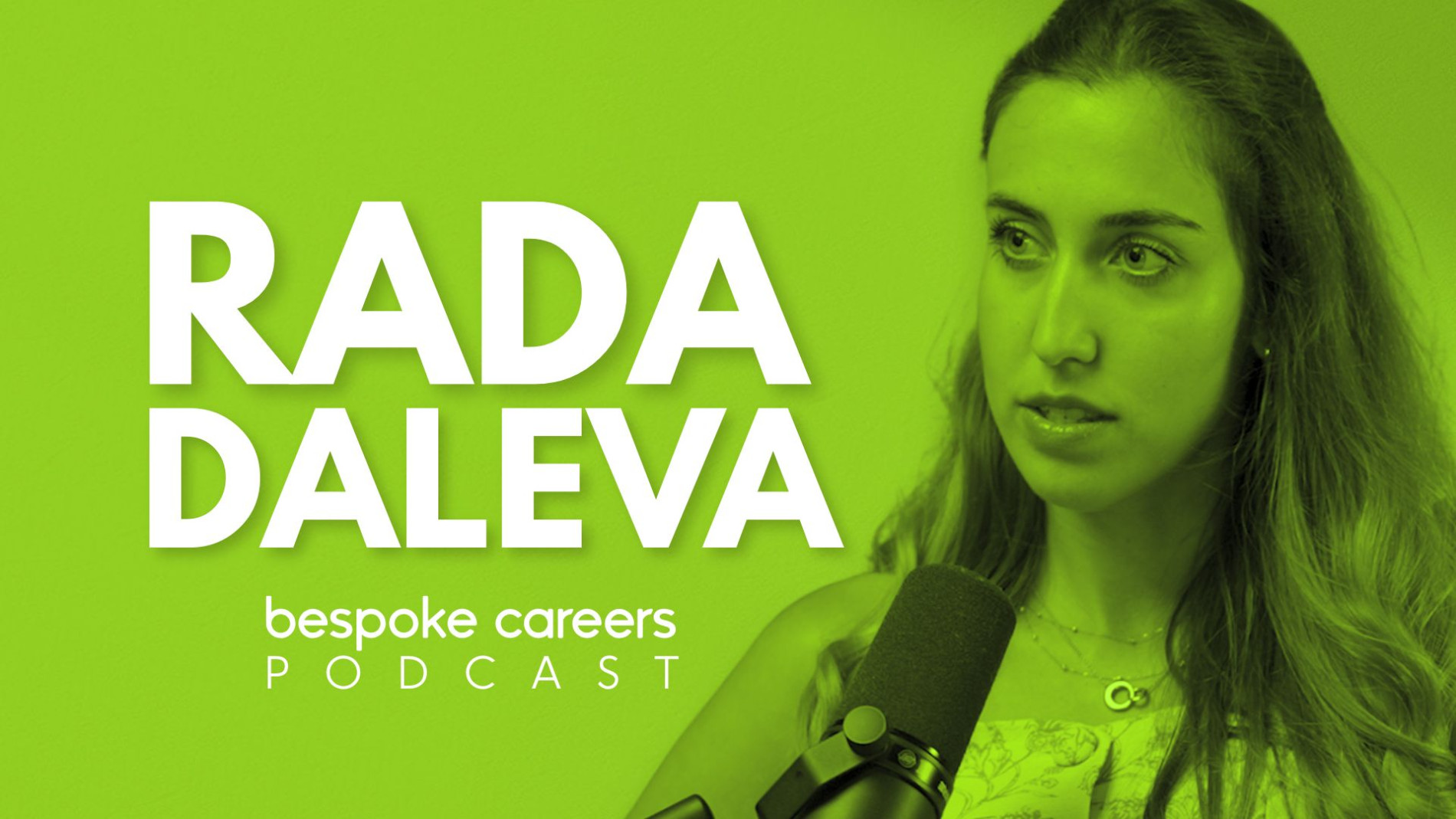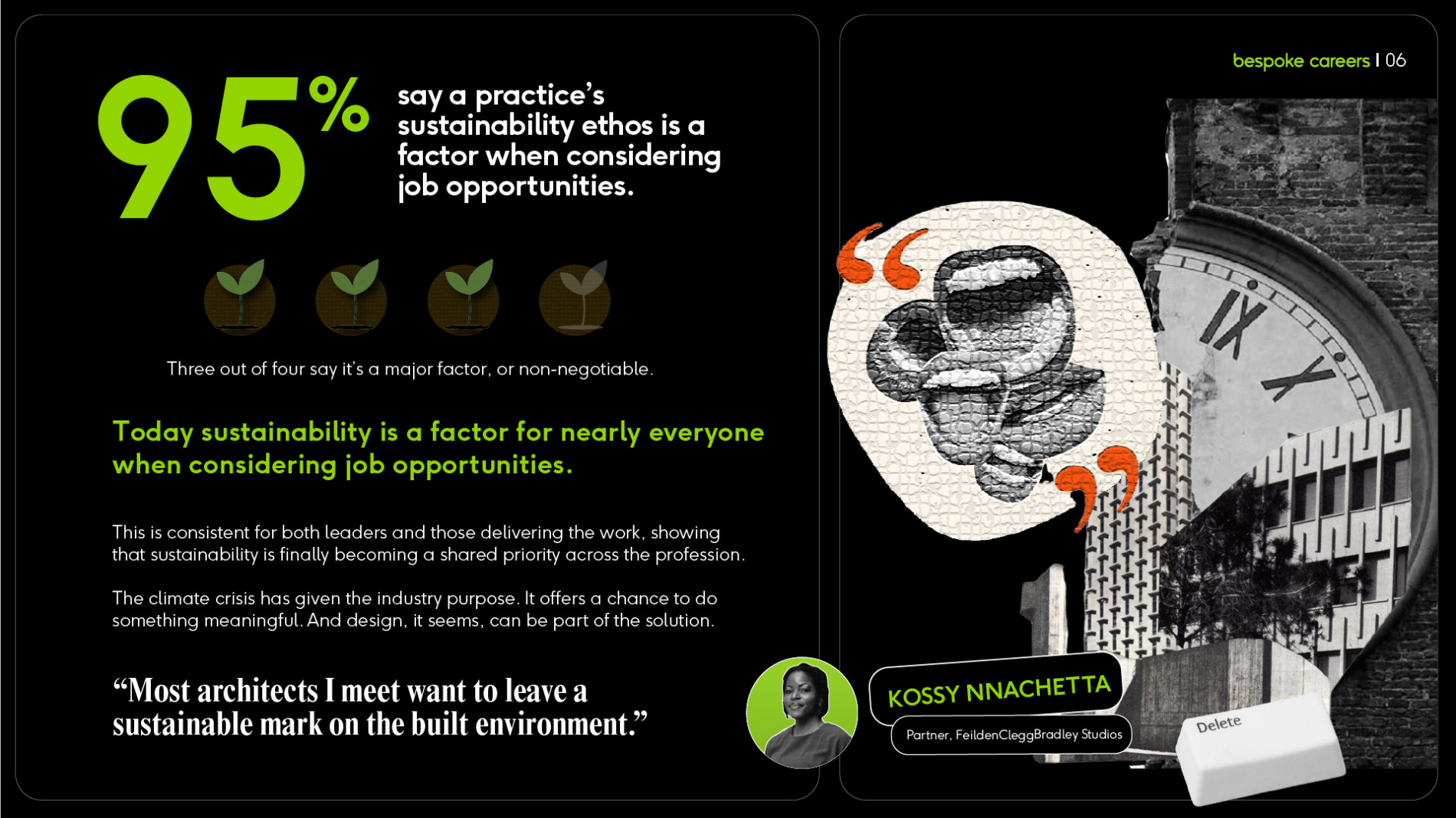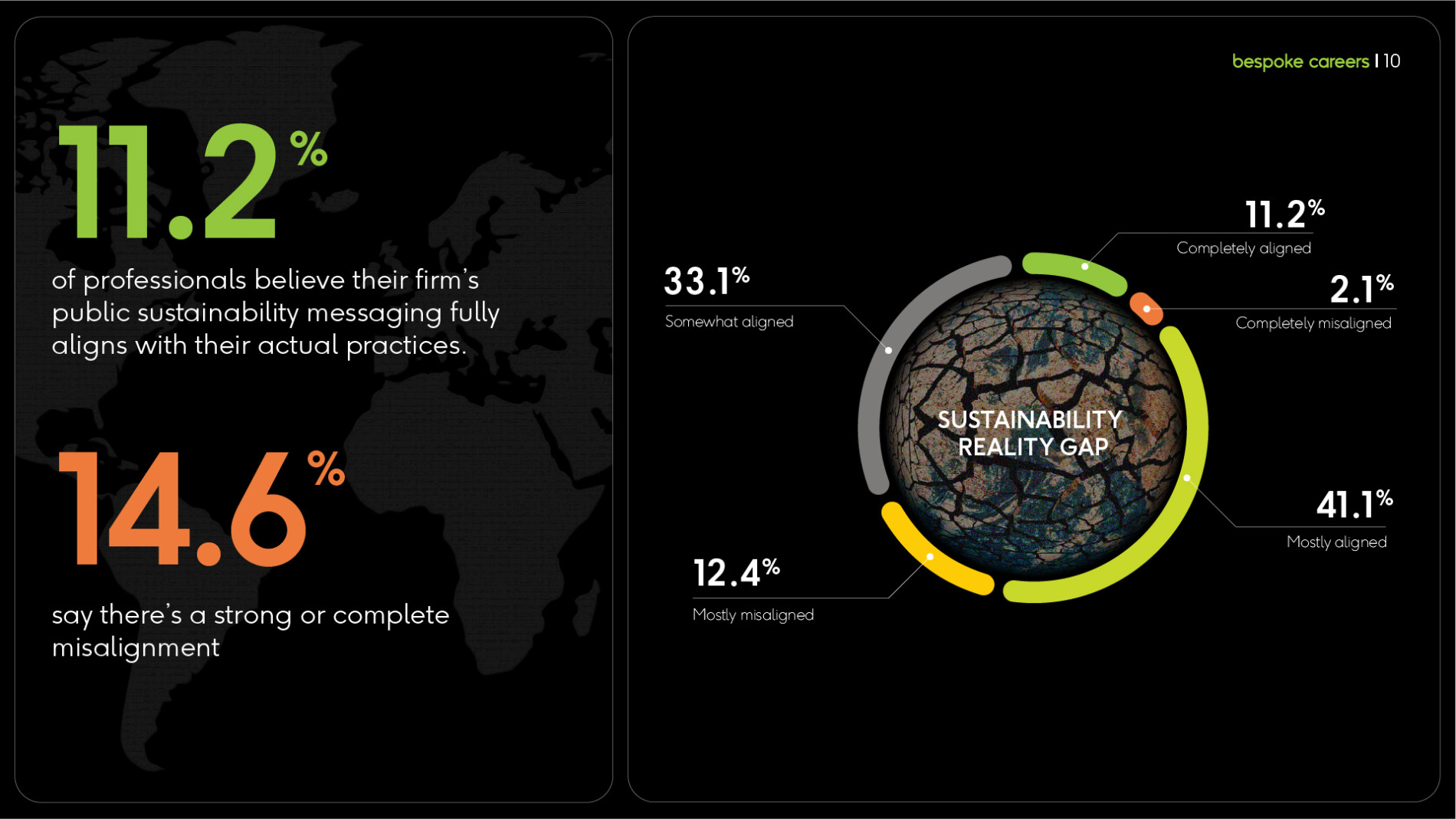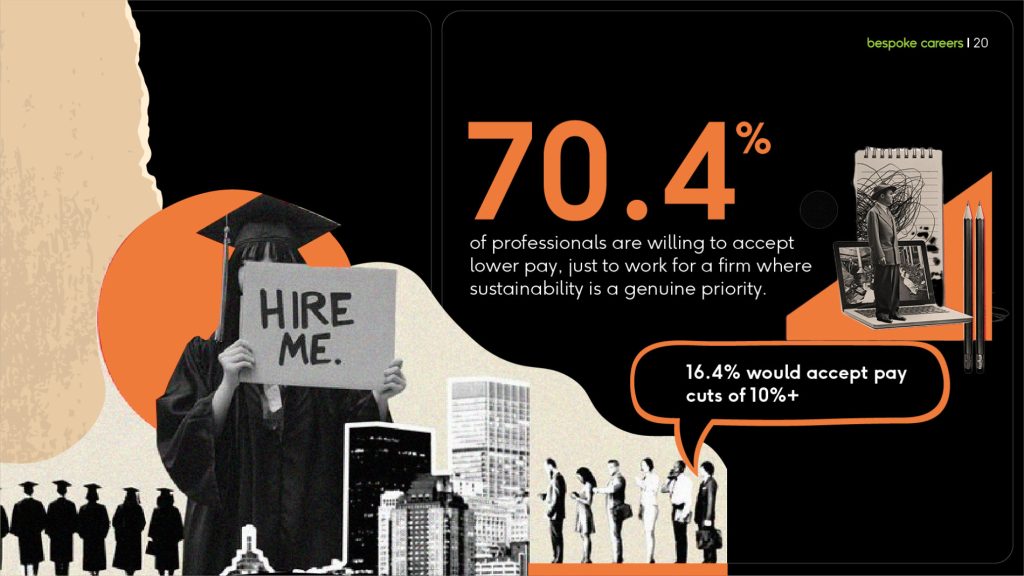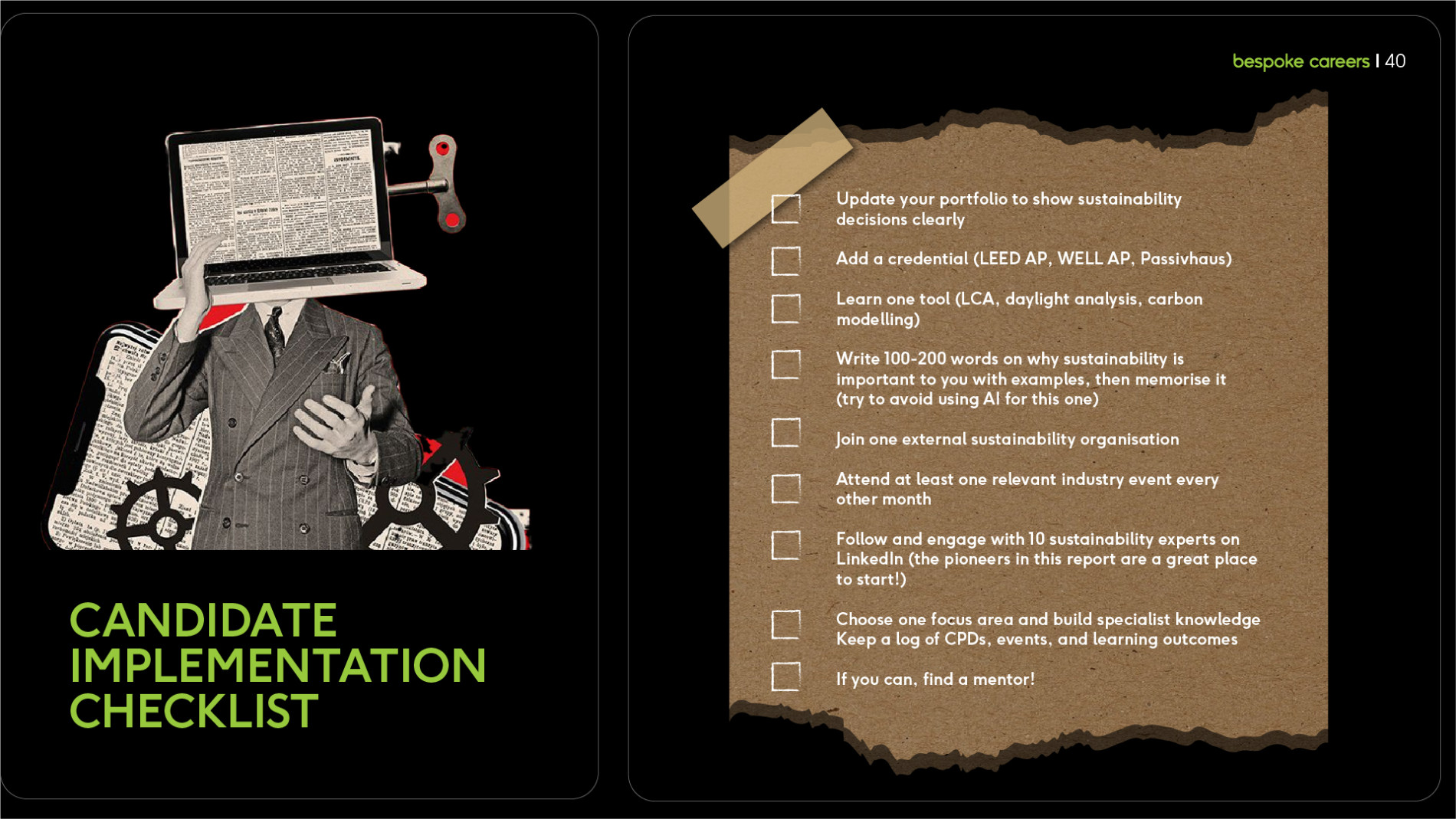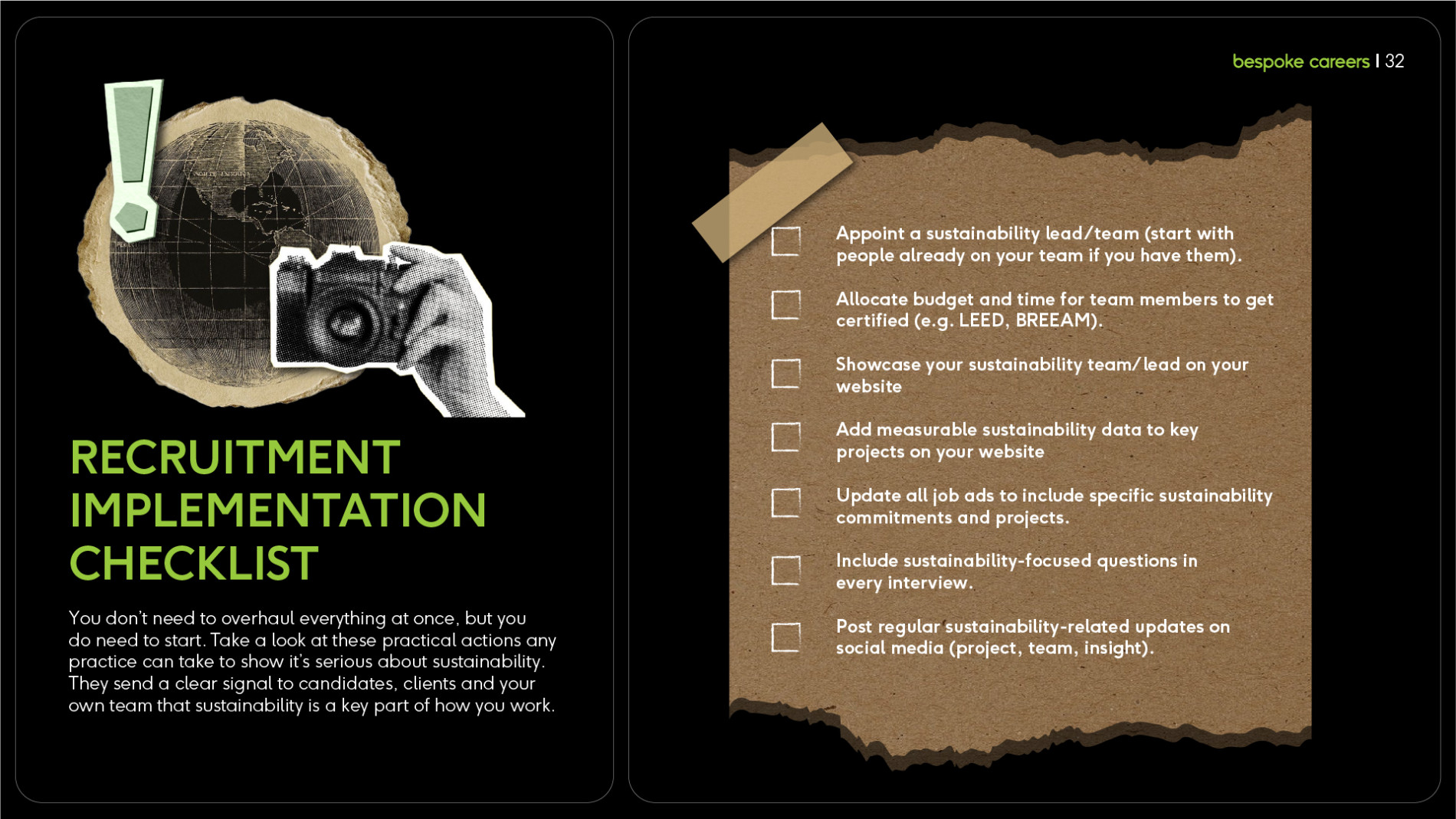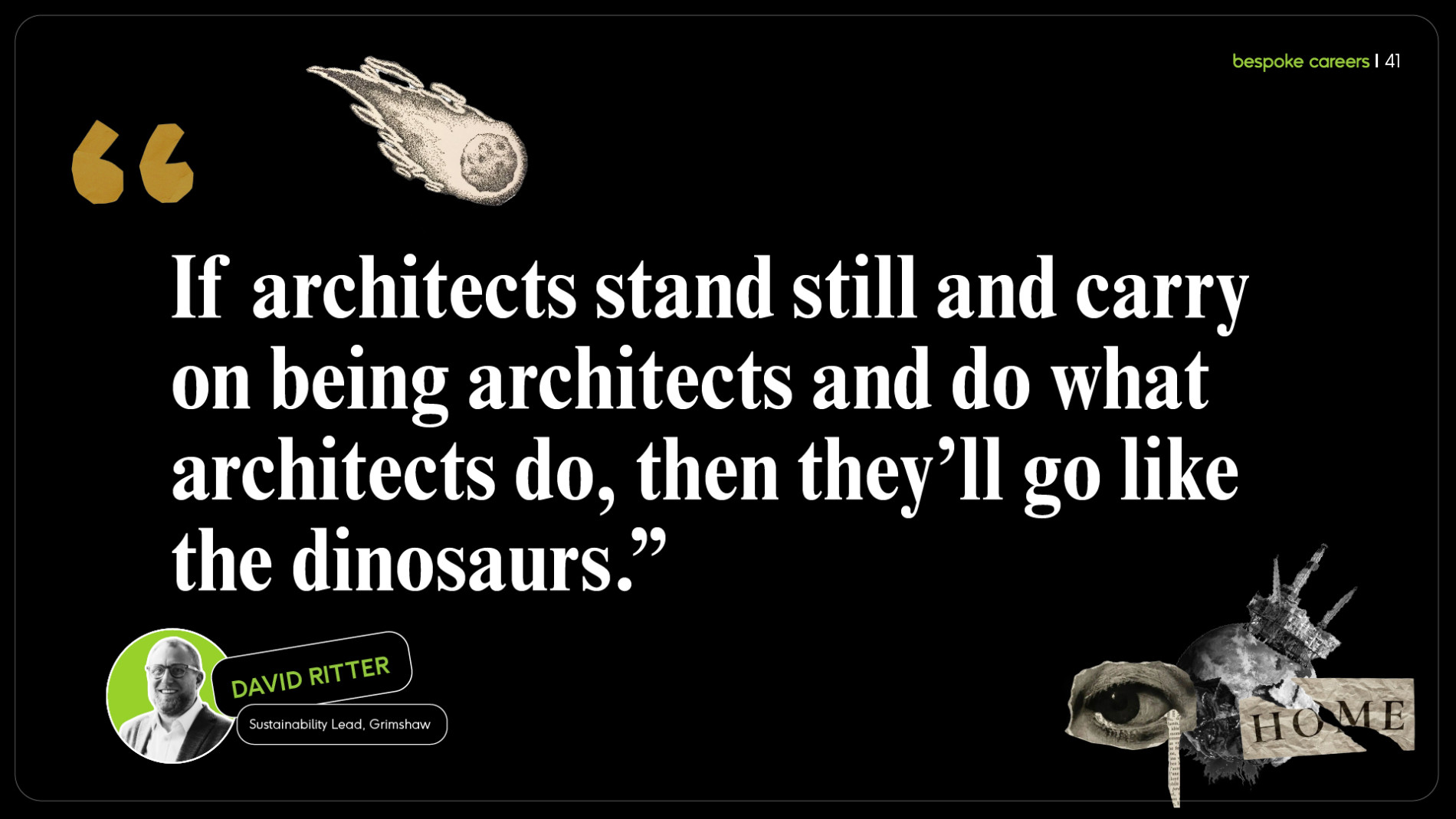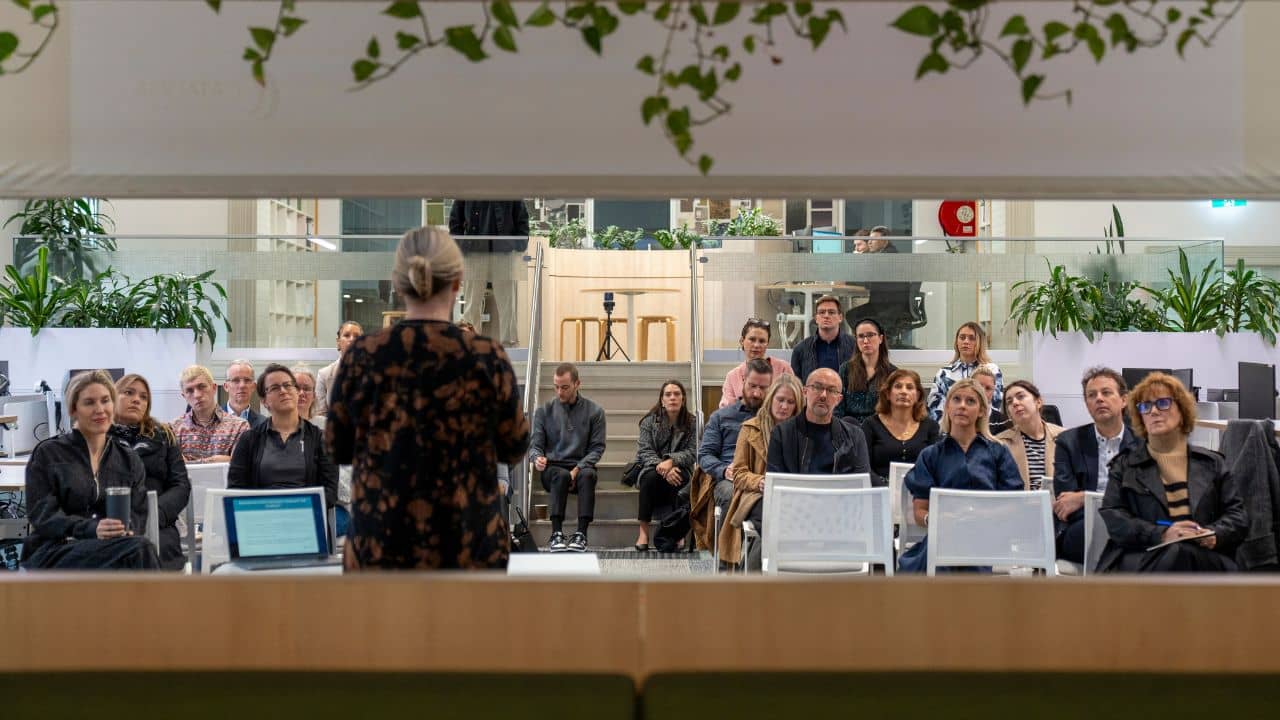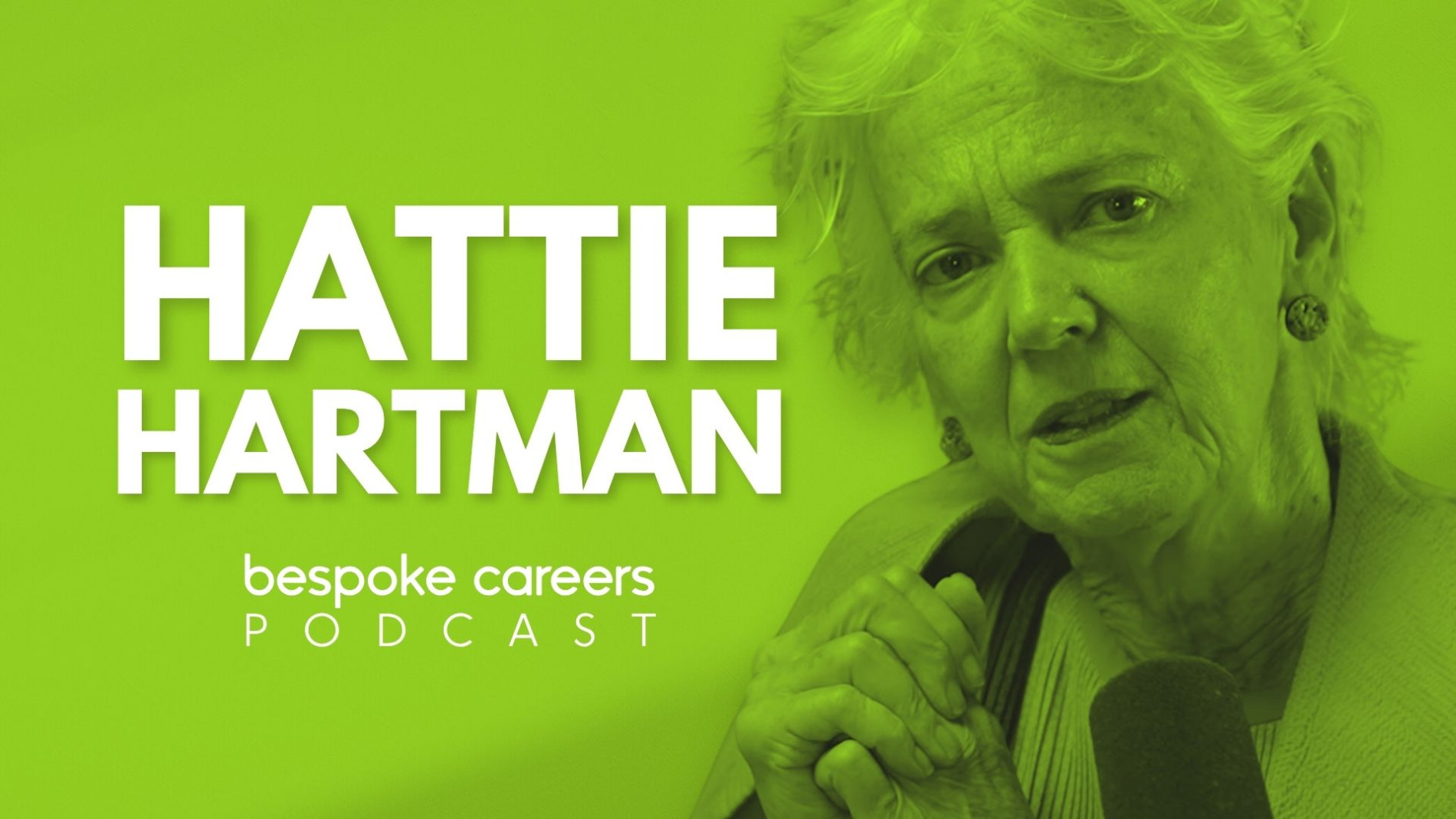
The State of Sustainability in Architecture and Design – Hattie Hartman
All designers want to make the world a better place. It's in their DNA. But what happens when that ambition clashes with reality? How does that clash shape the jobs that we take, the people that we hire, and the careers that we build in 2025 and beyond?
These are the questions at the heart of the Bespoke Careers Report and Handbook: The State of Sustainability in Architecture and Design in 2025. It’s a one-of-a-kind report offering a snapshot of where architecture and design stands on sustainability today and where we need to go.
We spoke to 350 professionals across the US, the UK, and Australia—from graduates to senior leaders—to understand how sustainability is impacting the hiring market. We also sat down with six pioneers who are leading that space: Andrew Waugh and Kossy Nnachetta in the UK, Tamar Warburg and Heather Holdridge in America, and Caroline Pidcock and David Ritter in Australia.
The second part of the report serves as a handbook for both sides of the hiring table. It’s packed full of practical tips for anyone who wants to maximize their employability in architecture and design, and for practices looking to attract and retain the best talent.
In this episode, I spoke to the report’s editor, Hattie Hartman. Hattie is the Sustainability Editor of The Architects’ Journal and the host of the AJ Climate Champions podcast. Trained as an architect and urban planner, she spent over a decade practicing internationally before moving into journalism. She is the author of London 2012: Sustainable Design and the co-author of Energy, People, Buildings, and more recently the co-editor of Materials: An Environmental Primer. An honorary professor of architecture at the University of Nottingham, Hattie is a leading voice on sustainability and design.
Why This Report Matters Now
Chris Simmons: Why now? Why is this report useful, and why did you and Bespoke want to write it and talk about this for the industry?
Hattie Hartman: When Bespoke approached me about this, I really hadn’t seen anyone else looking at this particular issue of sustainability and hiring and retention. In the last five years, this whole landscape has changed.
That doesn’t mean that delivering projects on the ground has changed. But there is a huge appetite from students coming out of school, from younger people in the profession, really wanting to change things. When they can’t find a practice that aligns with their mission… I mean, I was shocked by some of the statistics coming out of this. I felt they were very heartening, in fact, to see that 95% of respondents say that sustainability is a factor—nobody’s going to say it’s really not a factor—but the fact that a quarter of them have left or declined a job based on sustainability factors is phenomenal.
Chris: In the report, you note that most architects you meet want to leave a sustainable mark on the profession. That’s kind of a given in people’s careers. But for me, for example, I’m an architect who trained 15 years ago, and that was part of the agenda then. What do you think are the things that have changed over this period that mean people in early careers are actually taking it seriously and have it as an intrinsic part of their not only learning but also belief?
Hattie: I think part of it is what’s happening globally with wildfires, flooding—all these things are front and center in the headlines now. I think that architecture schools, some of them, are really starting to address this. And some clients are starting… it’s much more frequent, I think, for clients to come in the door wanting to do something about this, but they don’t have any clue what it actually entails to deliver this type of work. So that’s where the disconnect is.
Chris: With that disconnect, as architects, so many of us have that feeling. I suppose my biggest question out of the report is really about trying to understand how much of that is through education or lack of education, and how much of that is through coming up against an industry which is struggling to bring these things forward in a concrete way.
Hattie: I think that the construction industry is such a big thing to shift. It’s an ocean liner trying to shift things, and the only way to shift things is to have good examples that people can see and say, “Oh, you know, they did that, I can do this.” It’s also a very fragmented industry. To get everyone on board from the client all the way down to the facilities manager—the whole value chain—everyone needs to be pushing on this.
I’ve been writing about this topic now for almost 25 years, and almost every exemplar project I see, there’s one champion. There’s one person who’s on it from day one all the way to the end. And that’s what we need across the board.
The Need for Data and Evidence
Chris: So with that in mind, so much of it is about communication, presumably, and having—in my experience, for example—having the data, the actual evidence to back it up, to provide a compelling argument that isn’t just finger-in-the-air, big-picture speaking. Because I think we can all kind of get on board with the holistic side of things, but actually having the data, going back into the buildings afterwards to test the information, to understand the impact of what you’re doing…
Hattie: I think you’re absolutely right, and I’ve been banging on about post-occupancy evaluation and needing evidence for how buildings actually perform for so long. But it is starting to happen. I recently hosted a webinar for the AJ on whole-house retrofit, and we had a small practice—I think 10 or 12 people from the Cotswolds—one of the panelists was Charlie Luxton. He was saying that with the type of work they’re doing in the Cotswolds—often it’s individual homes, he’s also done some larger projects—they actually are doing whole life carbon calculations. We said, “Who’s doing it? Are you farming this out or do you have someone in your office?” And he has one person in his office who can do this and feed it directly in.
It’s no longer really good enough to just pass it off to an engineer. It’s not that everyone in the office has to be able to do it, but you need to have it at your fingertips so that when you’re designing, you can get those answers and also figure out how to present that to a client in a compelling, simple way. Which is not so easy, but I think more and more architects are getting to grips with this.
Chris: And I guess that is the role of the architect, isn’t it? Being able to communicate those things, to lead a design team, to lead a client to our solutions. Having that as part of our toolset is kind of key. And I think one of the things that comes out of this report is that ability to persuade a client. It’s no good to have all these great ideas if you can’t implement them, and you need to get your client on board. So more leadership training, more advocacy training. I think it’s not something you learn in school.
Disillusionment vs. Ambition
Chris: You also obviously talk about the disillusionment and the disconnect between the ambition and practice, and obviously that’s felt quite widely in architecture generally. It’s not obviously just about sustainability—it’s low fees and overtime and things like this. Obviously, the sustainability angle—finding a practice that aligns with your values—is really key and important for graduates now, and that’s evidenced in the report.
Hattie: Absolutely. I think what’s really great about this report—and this was an idea that came from Bespoke—is we’ve got a lot of how-to tips. We’ve got what can you do as a practice to make those things that you are doing visible so that applicants can see that, and what can you do if you’re an applicant to make yourself stand out.
I think still today—and all these six sustainability pioneers that I’ve interviewed said the same thing—you’re not going to be hired just because of your sustainability skills. You still need to be a good designer. That is top, front and centre. But if you can overlay a sustainability expertise or a deep knowledge of one particular aspect of sustainability with your overall design intent, that is a really useful skill, and that’s what people are looking for—to be able to integrate it. Really, to integrate it across the board. It shouldn’t be an add-on.
Chris: One of the really compelling figures in the report is that 11.2% of the people questioned found that their practices really aligned with what the practice is actually vocally saying about what they’re doing sustainability-wise. Obviously, that creates a huge amount of dissonance between practices communicating one message and not practicing what they preach in the work they’re doing. And I suppose whilst I completely can understand how the industry is slow to relate, that must create such a difficult position for those candidates coming into practice.
Hattie: I think it’s kind of normal, and it’s not just in the built environment that you can have these top-line objectives or even targets, but actually making sure that they find their way all the way down through even a small practice is not so easy. So I don’t think that’s so alarming. I think that’s kind of to be expected.
But I think what is possible is that everyone, no matter what level they are at, can be proactive and try to tackle things and change things. You have to have your antenna up and see where the gaps are and see what can you do on each project. What can you do within your practice? How can you bring things to the table? So you just have to constantly have that mindset.
Chris: I suppose with that in mind, having that leadership, having sustainability on their agenda every conversation… It’s not like it’s the young person in the office always trying to put their hand up and saying, “Can we make it sustainable, please?” It’s about that voice coming from leadership, I suppose.
Hattie: Absolutely. So even if the leadership doesn’t have the skills, they have to be willing—they have the message, sort of thing. But interestingly, and this is quite sobering, one of the stats that came out is only one in five sustainability leaders—so say a director in a practice—is saying that sustainability is core to what they do.
I mean, of course, everyone’s going to say sustainability is part of what they do, but some practices are really pushing. Like Archetype, for example, that’s here in London and in Edinburgh. They were founded on this, and that’s what they’re pushing. There are a lot of other practices that are now playing catch-up, but you need to have it core. Even if it doesn’t need to be the only thing, it needs to be central, and we still have a long way to go, I think.
Leadership and Sustainability Teams
Chris: What place do you think sustainability leadership within practices have? Because obviously there is now a move that lots of the major practices are now having a sustainability lead, maybe a small team, maybe a part-time team. And presumably the ambition is that being top of voice, being spoken about a lot, and that person having an active role has that sort of osmosis effect within the office to spread a wider message.
Hattie: Generally it does. I mean, it certainly can, and I’ve watched that happen in several practices, but you need to have support from the top. One example is Hawkins Brown. I think they started on this journey maybe 10 or 12 years ago. They now have a team of five. Certainly HMM as well. A lot of the bigger practices have now teams, and they’re resourced. The sustainability lead has a seat at the senior table and can feed things in. That’s what we need.
But there’s still a long way to go because oftentimes it’s a part-time role—a few days a month—and you just can’t look at all the projects as well as have a strategic view of how to drive things forward on a very part-time basis. If you’re juggling actual project work at the same time, it’s really difficult.
Chris: And you also mentioned that obviously when looking at candidates, having an area of specialty or a specific skill set—whether that is Passivhaus or carbon—again, is the ambition that that person spreads the word, spreads the skill sets throughout, over time and being involved in multiple projects, rather than having a general upskilling? I suppose it’s having key people that have a responsibility.
Hattie: Yeah, key people who have a depth of knowledge on one subject. You can put someone in charge of—I don’t know—even lunchtime CPD, making sure the lunchtime CPD is actually meaningful and that the suppliers who are coming in… because the technical people in these product manufacturers are really knowledgeable, and they can easily talk about one project, one product out of ten that is sustainable. But you need to vet them, and you can learn a lot from that. Or organizing office site tours of a project at a key stage. Say if there’s a lot of taping going on for airtightness, get everybody out there to see what it looks like and how it’s done at that key point. But these things often don’t happen unless someone’s kind of on it, someone’s driving it.
Would Accept Lower Salary for Values
Chris: One figure that I found incredibly interesting and slightly jarring was that I think 70% of people asked said that they would accept a lower salary based on a practice aligning with their sustainability values. And whilst that is incredible to hear from an ethical standpoint, it is also a very difficult thing to hear at a time when cost of living is high and we’re all sort of struggling through it and there’s all these conversations ongoing. How much of that do you think… are these two things opposing forces? Is it that you can’t have a sustainable thing without a profit-making idea? And does it always have to come down to the money aspect?
Hattie: Well, first of all, that is the one figure that came out that I was like, “Really?” And I did show it to my 28-year-old daughter last night, and she said, “Really? Architects are crazy.”
I do think that I mean, we have a tendency to want to change the world and give things away without charging enough. And if sustainability is baked in from the beginning of a project, you can achieve a huge amount without a huge cost uplift. So that’s what we all have to get to. When you come in after the sort of initial scheme is set and try to start doing things, it’s too late.
So I think, but in terms of the salary question, I would find it astonishing… We’re all hopeless dreamers.
Chris: So I suppose with that in mind, do you think that having sustainability as part of the agenda, part of the job role, part of the job description, has an attractiveness for candidates to get the best talent to your team?
Hattie: Absolutely. I was up in Edinburgh last summer to give a talk about my materials book, and I visited Archetype’s office there, which they only founded seven or eight years ago, and it was buzzing. It was packed out. They’ve got so much work on, and it is a place people want to work because they believe in it and they believe they can learn the skills that are crucial going forward.
Moving Beyond Lip Service
Chris: With that in mind, how do practices move away from just providing that lip service? Because obviously we speak about Archetype, there are other very pioneering practices—Field and Clay Bradley—that have been formed with sustainability as a key. And there are obviously lots of other practices which probably feel like they’re trying to catch up with the industry or catch up with their competitors. What are those moves that we need to be making that make sure that we’re not just providing lip service, that we are imbuing those values and we are actually making change?
Hattie: Well, I don’t think you can change things overnight. You can start to say no to certain projects, which is very difficult, but you can also shout really loudly about the best ones and feature them on your website, get around to industry events and talk about them. So really, really push the exemplar and make sure they’re all over your social media. We need to see those best practices.
And what’s interesting is I think that the media landscape and the awards landscape is changing. When I first started writing about this, there used to be a RIBA sustainability award. Then it was discontinued because everything is meant to be sustainable, which is completely ridiculous because you need to shine a light on the best practice for others to be able to recognize it. And now, the RIBA has—often I think they try to have a sustainability expert on every jury, which is great. So that is huge progress. But that’s what we need. We need to see the best examples.
Chris: And I think that is a wonderful thing. I mean, you mentioned Leti—there are lots of organizations which are willing to give their research away. It’s all open source, it’s all open to the conversation. I’ve attended lots of Leti lectures that have taught me a lot of things, and it’s all there to be enjoyed, learned from, and embraced, I suppose. So I think that is a wonderful mindset to lots of people in this space that are experts. I know Field and Clay Bradley have tools—their tool that you generous… it’s a very generous space, and it always has been as long as I’ve been involved with this.
Hattie: It’s a very generous space, but what’s changed is five or six years ago it’s like, where do you go for information? Even when I went to the very first ACAN meeting on a dark November night at a pub in Dalston, I ended up at a table which was the comms table, and I asked the other people at the table, “Where do you go for information?” And someone said, “There’s no good podcast,” which is how I got started on the podcast journey.
But the main thing is that it used to be there wasn’t that information available. Now you go to the Leti website, you download all these things. You go to Architects Declare—incredible resources on their resources tab. And not just in the UK. I mean, the AIA also in the States has loads of information, and they’ve been on this journey for a long time. And that came across speaking to the experts in Australia as well. Now the information is out there. There’s really no excuse. Still have to digest it, of course.
Six Global Experts
Chris: And you mentioned those experts. In the report, you speak to six experts. What was your criteria for talking to them, and are there any key takeaways that you took from your conversations?
Hattie: It was interesting how similar their outlooks were and how it really is a global issue now. It really came back to the powers of persuasion—that we know what has to be done. It’s kind of doing it, and I think that’s where we are now.
And part of it is having those who are leading the way talking to each other. And there are now more and more organizations that are making that happen. Built by Nature, based in Amsterdam, they’re doing a lot of work on timber and building with bio-based materials, and they’ve set up a network of frontrunners so people can talk to each other. And what’s great is across boundaries. They’re now working in France, they’re working in Germany, they’re working in Spain. The momentum is building. I really think it is building, but it’s a big ocean liner to turn.
Skills for Candidates
Chris: The report, obviously, in its latter halves breaks down into two handbooks—one for candidates and one for practices. With the candidates, it talks about what practices are looking for, what sort of skills candidates should be focusing on and communicating to practices. What are some of those key skills that you found are most important and aid employability for candidates?
Hattie: Well, I think anyone going into an interview who cares about sustainability needs to have a clear and concise statement that they can make that is not rehearsed but that just sounds authentic. I think that’s… and one—I think it’s Casey from Field and Clay Bradley—who says, you know, a passion for sustainability comes from a deeper place, and that can come across in an interview.
It’s not that you have to have huge experience, but you can demonstrate a project you’ve done in school, what the premise was, how you carried it through. Or if you have actual experience on a project delivering something, you can explain that in the context of all your other skills, design skills… It has to be a personality fit with a practice as well. So sustainability is only one bit of it. But if you’re able to present that in a persuasive way, it can give you a step up.
And I think everyone across the board has said the younger people coming into the practices are the ones who are really leading the way on this. And what’s interesting is that it’s often a leadership opportunity to actually take on more responsibility at an earlier stage in your career if you have these skills and you’re proactive about it.
Chris: It’s a wonderful response, and in my personal experience working with young people in practice and having people come in with that passion, with that energy, that is able to shake things up. Because they’re coming at this thing fresh, and maybe they have a bit of naivety, but that’s brilliant because that does challenge the status quo and it does make things at least have a bit of effort and change to it.
Hattie: Totally.
Chris: And is that a similar message that came from all of those six experts, with people they’re looking for, the candidates that they’re searching for? Are those the values that they’re looking for? Is it just about value?
Hattie: It’s about the ability to see the big picture and dive into the detail. And I think Heather Holdridge from Lake Flato in Texas said it well. She said, with sustainability, you’re always going to be learning new things. And so we’re looking for people who are curious, who are going to be able to take on a challenge and do the research to figure out what’s the best solution to a particular problem. And that ability to overlay a sustainability ethos to everything you’re tackling… It sounds simplistic. It’s not easy to do.
Practical Checklists
Chris: One thing that’s really great about this report is there’s a to-do checklist for applicants—for both sides of the hiring table, but for applicants in particular—of how you can really quickly upskill yourself or start to upskill yourself in this area. Simple things like get yourself on LinkedIn and start following eight or ten people who you can spot who are really leaders in this area, and you can quickly… one thing will lead you to the next thing, will lead you to another report. There’s a whole list of very simple things that you can do to jumpstart this process.
Chris: And obviously we’ve spoken about the candidates. How should the practices—and I think this is mentioned in the report as well—how should the practices be looking to retain the best talent, to attract and retain those best and sustainability-minded people?
Hattie: So I think we honed in on three real aspects of this. One is you’ve got to have the good projects, and those projects need to have evidence behind them. So measuring the impacts of your best projects.
And then where is the expertise in the practice? Foreground those people who have got those skills. Have them out in industry events. Have them on your website in news bulletins or thought leadership pieces. Put them out there so that candidates are going to look at your website, they’re going to look at LinkedIn, they’re going to look at your social media. Those places need to be foregrounding this—not just the projects but also the people behind them.
And the last… there is one more point. As a candidate, you really want to: are you going to be able to learn? And some practices offer actually training. And interestingly, again, Lake Flato in Texas, they require everyone who comes on board to get a certification within six months of joining—could be LEED, it could be the Living Building Challenge. And many practices in the UK offer Passivhaus training now. So that’s attractive if someone’s really wanting to skill up, to think that they’re going to be supported to do those things.
Chris: It does have that feeling of we are taking it seriously, that it’s not just something that’s spoken about. It’s something that’s actually implemented. And you can ask those questions in the job interview rather than sort of leaving them unspoken—like specific questions about sustainability. They often don’t feature in job descriptions.
Chris: How important do you think having a named and almost displayed sustainability lead or sustainability team is within these practices? Having someone that’s accountable, visible for other candidates to see that you’re taking it seriously, and for your clients and for other people within the industry to understand that this is something that you are… it’s part and parcel of the practice.
Hattie: I think applicants are really looking for that. They’re looking to see, is there a sustainability lead or a sustainability team? Who are they? I think it was half of applicants said that that was something that they look for, which is fantastic. I mean, five years ago that certainly wasn’t the case.
And now in the UK, the sustainability leads have a whole network where they talk to each other. They had their first away retreat last summer. I think another one’s being planned for this autumn. So it’s all building. It’s growing.
The Future of the Profession
Chris: So there’s this quite poignant quote at the end of the report by David Ritter that makes the comparison, “If architects continue being architects, they’ll go like the dinosaurs.” And I wondered what you thought about that quote and what you think generally about the future and the idea of our adaptations or dying out, sort of thing.
Hattie: David Ritter is speaking on behalf of Grimshaw from Melbourne, and it’s fantastic to hear him say that—that coming from a large established practice—that view, because it is so true. We just can’t carry on the way we’ve been carrying on.
And retrofit is where it’s at. Retrofit is in the schools, retrofit… We need to get to grips with what to do with our existing buildings. And I think part of this whole challenge is being able to question the brief. If a client comes to you and wants to build a big, bold, shiny new building, maybe you can say, “Let’s have a look in a 25-mile radius and see if there isn’t an existing building that could fulfill this brief that we can modify.” I mean, that is turning architecture on its head, and that’s what we need to do.
I think David is right. I think the future of the profession is incredibly exciting. I think architects have the strategic mindset and the technical skills to address these challenges. If I were starting all over again, I might be a landscape architect because I think you need to understand the ecology of a site before you draw a line or make a line on a screen. But I think collaborating across disciplines is also where it’s at. I think it’s happening more and more, but I think it’s tremendously exciting.
Chris: Do you think the collaboration piece… because personally I’ve always found that structural engineers are very good at communicating—or at least in my experience of working with structural engineers, they’ve always been very good at communicating—that big picture idea of, you know, we could go down this route, this route, and this route of the structure of the building, and they have an intrinsic understanding of how much intensive carbon that would be to go down a different route. And that feels like it comes from a place of mindset. So there’s this idea of we could do it X, Y, Z, or we could retain the existing thing, but it also comes from a mindset of having the data to have that understanding and have the tangible… the feel for it that is convincing.
Because obviously, in my experience, having worked for a lot of developer clients, we completely went from a mindset of “obviously we’re going to knock this building down and we’re going to put something much bigger in” to very recently, in the last couple of years, being of the complete opposite mindset and saying, “of course we’re going to retain this building, and how are we going to do that?” And that for me came from a mindset shift—obviously a political one as well because of all the stuff that was going on with the Marks & Spencer’s in London, for example—but it was that sort of big shift in just belief, if you will.
Hattie: Yeah. When I first started on this journey, I spent a lot of time talking to services engineers, mechanical engineers, because it was all about operational carbon. And that shifted about 10 years ago, and now the structural engineers are really where it’s at. I think yes, I think the engineers do have… are more comfortable sometimes with these numbers, but as architects we really need to get to grips with that and be able to be on top of that agenda and be on top of those facts and be very good at presenting them graphically in a way that clients can relate to. And I think all those skills are skills that architects have completely.
Chris: Do you think those conversations are had early enough? Are we in the room?
Hattie: The problem is that often there’s not enough resource for a client to hire the engineers right at the beginning. And so many practices have engineers in-house now, the big ones. But yeah, I mean, what can you do? You have to get in there as early as possible.
Final Thoughts
Chris: Completely. I think the report was interesting because people obviously had thoughts that this report… just to say, I thought it was an interesting idea, but it’s gone way beyond what I thought it would achieve because it really sets out an appetite from the profession for change. And it also sets out in such simple terms here are some simple things you can do to start this journey. And it’s an easy read. It’s presented in a very imaginative graphic novel style. And sustainability is often a dry and boring topic. But in this case, it’s a good read. It’s a great read, actually. So I hope people will download it and have a look, flip through. It’s just 40 pages.
Chris: And what do you think is the big takeaway, the big benefit of the report?
Hattie: I suppose the big takeaway is that sustainability is where it’s at. And as David Ritter of Grimshaw said, if you don’t get with the program, you’re going to be out like the dinosaurs.
But I think what makes it a compelling read is that it’s not preaching. It’s actually giving you easy, navigable steps of how to get on this journey and move forward and put yourself forward—how people who want to hire can find the best talent, and how people who are looking for jobs can put themselves forward in the best possible way.
Chris: I found it intriguing that the report is actually structured in a narrative manner. Was that intentional?
Hattie: Well, that’s why it’s such an easy read, because we’ve structured it in four acts. It’s kind of like all the high hopes that you come into the profession with—Act One, all the high hopes. Act Two, the disillusionment. Act Three, what can we do? And Act Four, the future—where do we go from here? It just flows. And it’s not all a bunch of pie charts and data.
The other thing I would say is that this is a big-picture look at where sustainable design sits globally in these three different markets where Bespoke works—here in the UK, in the US, and in Australia. But it’s also structured and intended to be of use for an individual. So as an applicant or as a person hiring, there are lots of easy-to-grasp tips about how to take this forward.
Chris: And interestingly, the narrative probably follows the feelings that someone has in their career. So they start in that initial university days of high hope and being able to change the world, the struggles they go through in practice, and then here we are now trying to look for a way forward. I guess it’s a hopeful picture.
Hattie: It’s a hopeful picture.
Chris: Hattie, that was absolutely fascinating, and I’m excited for the report to go out and be shared. Thank you so much for joining me.
Hattie: I hope it will get really good traction, and it certainly deserves to. And I think it’s a really impressive take on how to unravel the complexity of sustainability in a way that people can easily understand. So where do we go to find it?
Chris: You can download the report from bespokecareers.com, and I’ll certainly be posting it on my LinkedIn. It should be easy to find.
Hattie: Thank you.

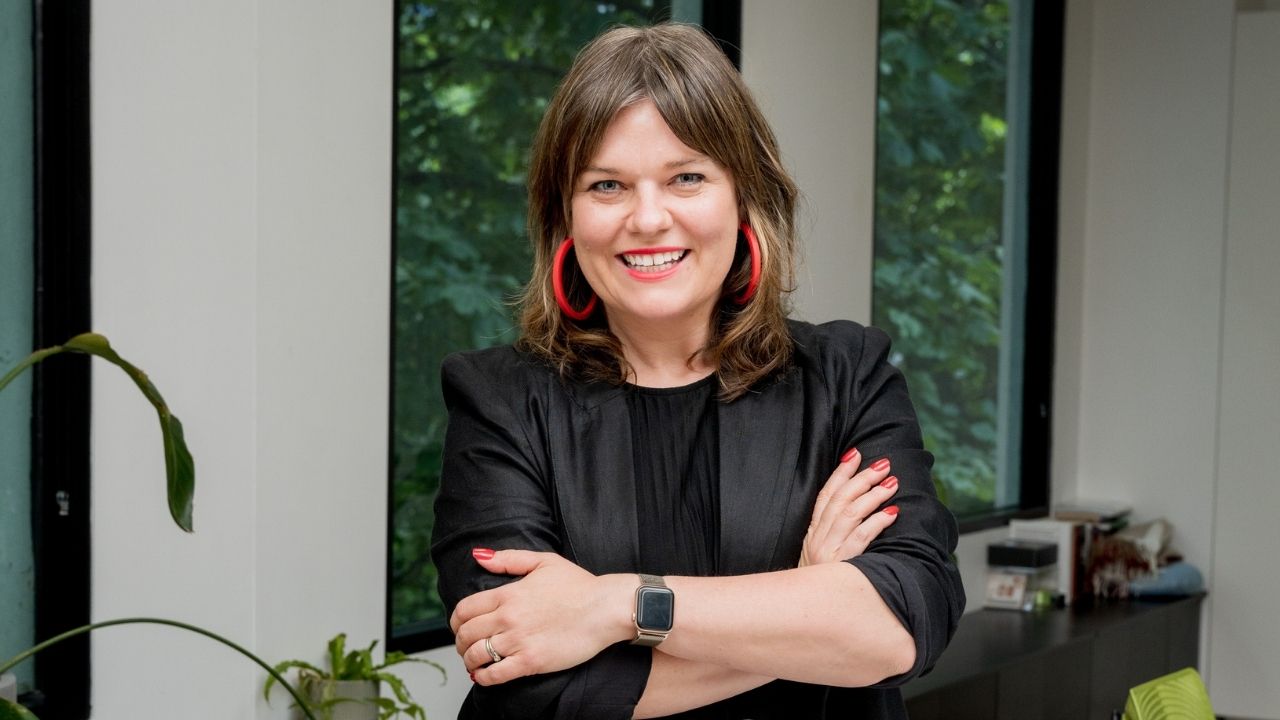
Looking to hire top talent
 or advance your career? Let's talk.
or advance your career? Let's talk.
We connect exceptional firms with talented professionals.
Let’s discuss how we can help you achieve your goals. Get in touch with the team today.
Related Posts

Trying to make sense of the new Australian workplace laws and what they mean for architecture firms? With Catalina Consultants’ managing principal Merilyn Speiser, we demystify the Government’s Closing Loopholes legislation and other amendments to workplace laws for employers and architects.
We were delighted to sponsor and attend the “2024 WIA Mentoring Programme Celebration: Forging New Paths,” marking the successful conclusion of this year’s mentorship programme.
Balancing work and family life during summer holidays and beyond is challenging for parents and carers, but creating a supportive workplace can make a significant difference, writes Bespoke Careers’ London based MD, Jimmy Bent.
